 Voltage Feeding SCV Loops
Voltage Feeding SCV Loops
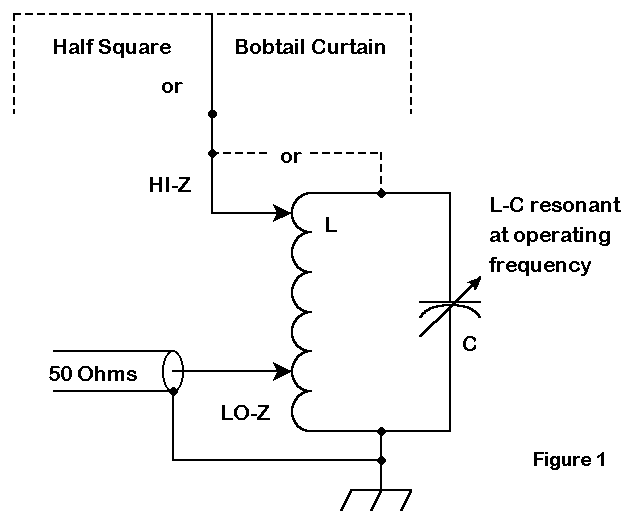
The circuit for effectively feeding a voltage node of the open-ended SCVs is in Figure 1. The top--or a tap near the top--goes to one of the half square verticals or to the middle vertical of the bobtail curtain. This remote circuit can be set and weather sealed.
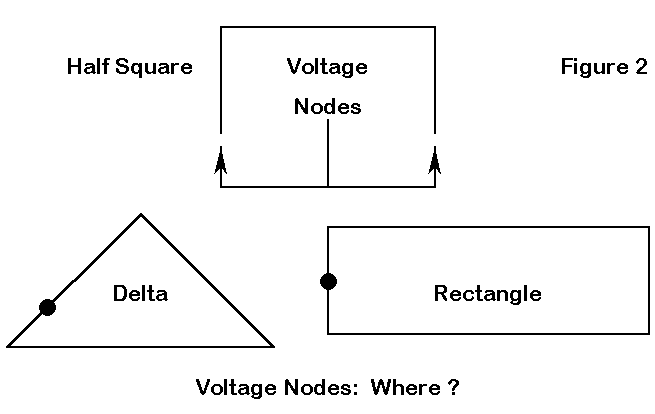
The loop versions of the SCV--the triangles and rectangles--present a different problem, as revealed in Figure 2. They have no exposed ends. Moreover, the current node of effective SCV operation with a maximum of vertically polarized radiation is way off to the side and elevated.
The shame of it all is that the loops can be used as general purpose wire antennas for most of the ham bands above their resonant SCV frequencies. However, they operate better in this role if fed at the center of the bottom. You will need balanced feeders and an ATU, just as you would for a doublet.
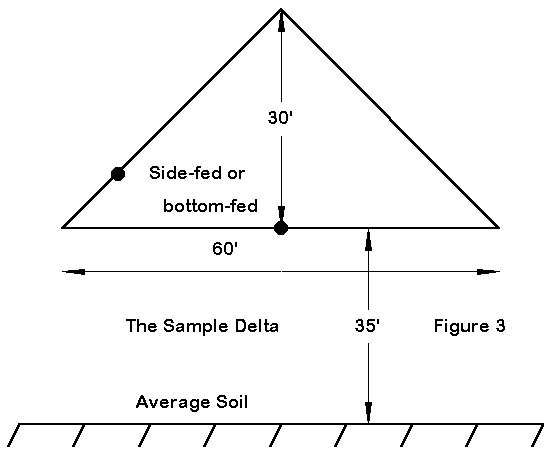
Just for initial comparative purposes, here are some numbers for a right- angle delta, resonant for SCV use at 7.15 MHz, with its base at 35' and its apex at 65' up over average soil, as sketched in Figure 3. The first numbers list the gain, take-off angle, and source impedance if we attempt to feed the antenna on all bands at the SCV side feed point, about 12% up the triangle leg. The second set give the same modeled data if we feed the antenna at the center of its base leg.
Right-angle delta: side fed Frequency Gain dBi T-O angle Source Z (R+/-jX) 7.15 MHz 1.97 16 degrees 49 + j 0 10.1 4.60 57 5700 + j4500 14.15 6.92 37 115 + j 135 21.2 6.42 22 270 + j 295 24.95 7.96 18 790 - j 105 28.5 8.10 15 435 + j 510 Right-angle delta: bottom-center fed Frequency Gain dBi T-O angle Source Z (R+/-jX) 7.15 MHz 5.83 42 degrees 255 + j 75 10.1 7.57 29 3510 + j2100 14.15 7.47 35 175 + j 120 21.2 7.90 14 235 + j 350 24.95 8.91 68 665 - j1150 28.5 8.49 15 615 + j 415
Where SCV-type operation is not involved, on every band except 12 meters, the bottom fed loop shows either higher gain or a lower take-off angle than the side fed version. Hence, for general use, the bottom-center position is the better feed point. Of course, it is also more convenient than the side position.
It would be nice if we could get SCV operation at the same point. We can.
For SCV operation, we cannot simply place the feedline in series with the wire, as we would for general operation. Instead, we must separate the wires a bit at the very center of the bottom. This is the equivalent to the first step in converting the antenna into a half square. This position is a high voltage node where the current reverses polarity. Separating the wires at this point does not materially affect the gain or take-off angle of the antenna. In other words, it does not affect the ratio of vertically polarized to horizontally polarized radiation.
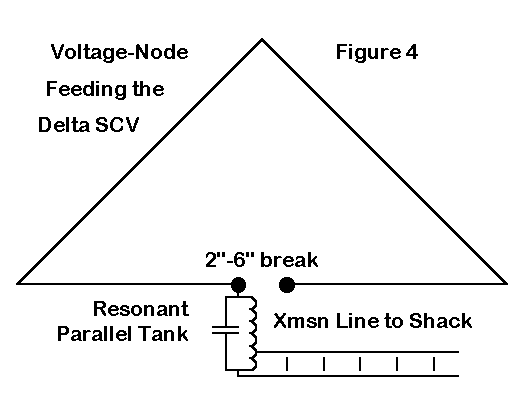
However, as shown in Figure 4, we shall not change the shape into a half square. We shall retain the delta shape. The spacing of the break in the wire is not critical--2" to 6" appears to make no significant difference. For the particular right angle delta model we are using, opening the bottom did not change the gain, take-off, angle, or source impedance. More precisely, the source impedance with side feed changed by only a fraction of an Ohm. Moving the side feedpoint to the bottom changed the impedance, but not the gain or take-off angle.
We shall leave one end of the wire at the bottom-center break unattached to anything. The other end, we shall attach to the very same parallel tuned circuit we might used to voltage feed a bobtail curtain. The antenna source impedance will be complex and high, with the resistive component in the 3500 to 4000 Ohm range and the reactance between 8000 and 10000 Ohms. A good high-Q coil with well-spaced turns to prevent arcing and a good variable capacitor, also with wide spacing between plates, will handle the job easily. The only task is patiently finding the right tap points for both the antenna and the feedline so that a coax line sees 50 Ohms.
However, since we are making this move to use the antenna with parallel feedline, the situation is not so critical. The use of the parallel tuned circuit is still recommended, since the impedance of the antenna end is still very high even with 600-Ohm parallel line. However, we need only find a tap that approximates the line impedance and let the tuner in the shack do most of the work. In fact, with this system, once we find a good setting, we can replace the variable capacitor with a door knob high- voltage capacitor and protect the expensive variable from the weather.
We shall still need a weather proof case for the capacitor and the coil. So we might as well add either a knife switch for manual operation or a relay for remote operation. The switching job is this: when we wish to use the antenna as an SCV, one side of the base-leg break goes to the tank circuit and the other goes to nothing. The feed line goes across the tap(s) on the coil. When we wish to use the antenna for general operation, the tank is disconnected and each side of the base-leg break goes to each side of the parallel feed line. The switching, suggested in Figure 5, may require 3 sets of contacts.
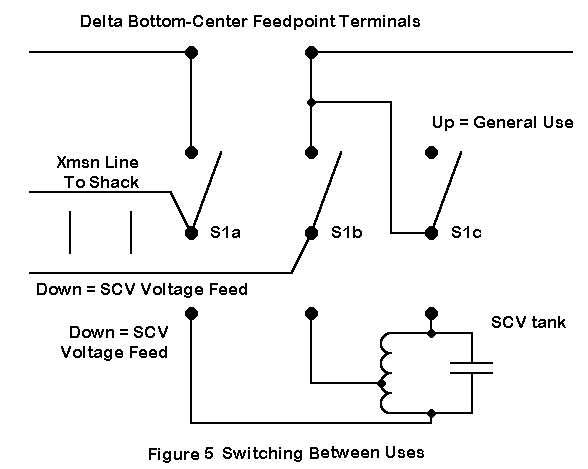
This system should work equally well on rectangles as well as triangles.
If you are inclined to try this system, I recommend that you start with a
manually switched system to see if it will suit your needs before you
invest in a remote switching system.
Updated 8-14-98. © L. B. Cebik, W4RNL. Data may be used for
personal purposes, but may not be reproduced for publication in print or
any other medium without permission of the author.